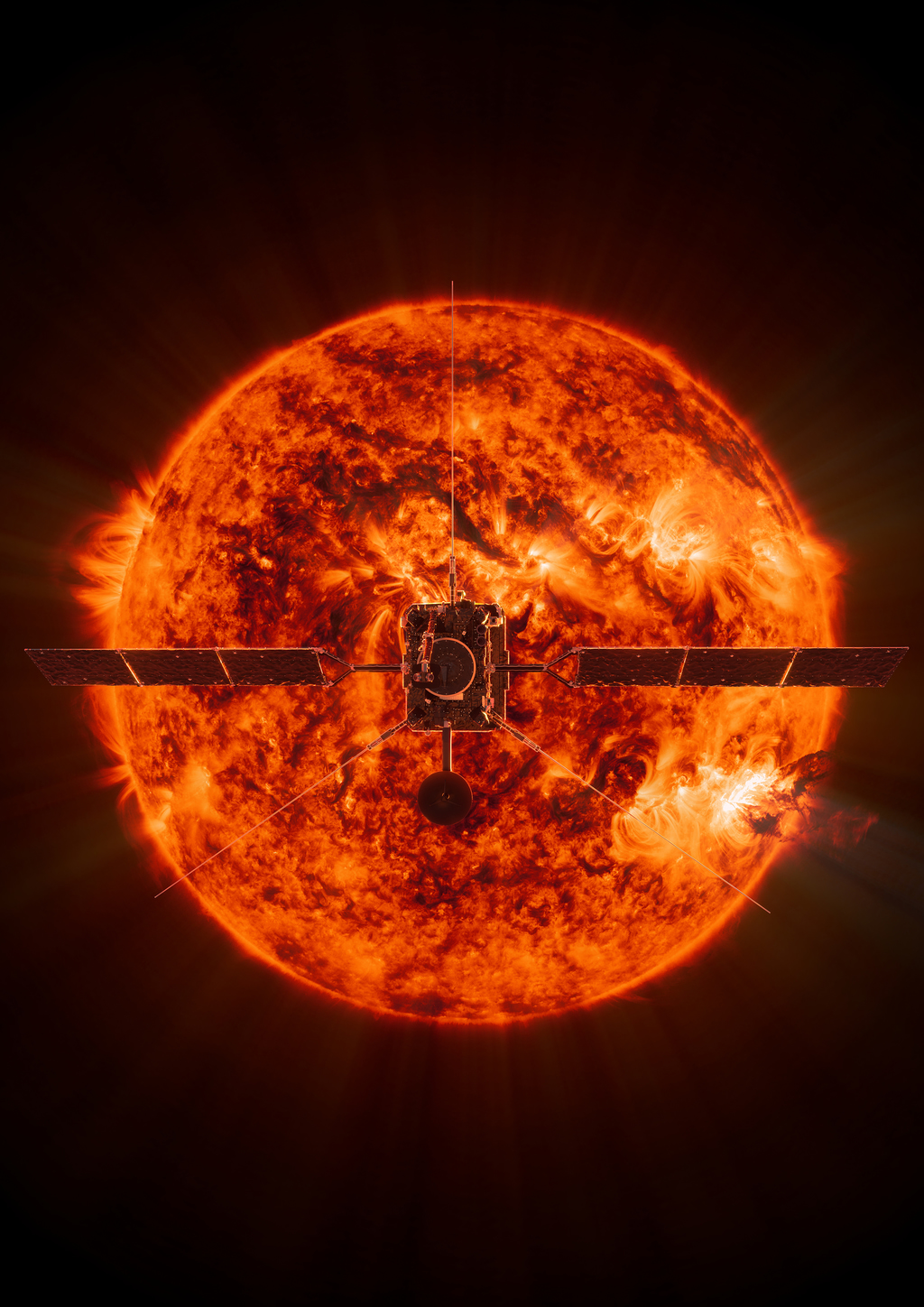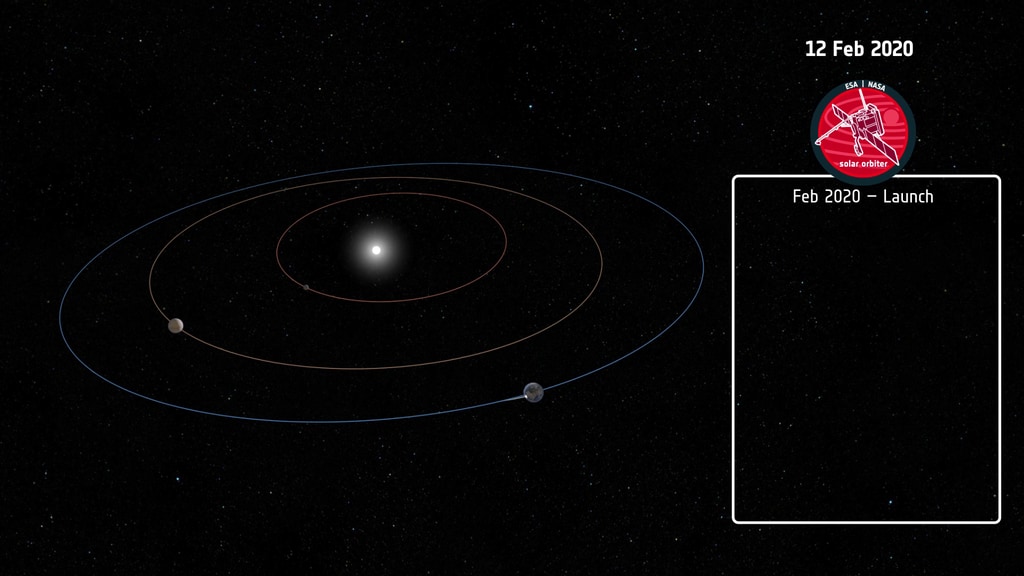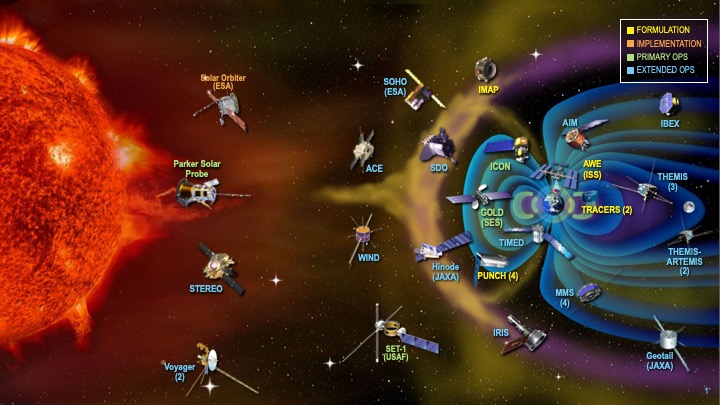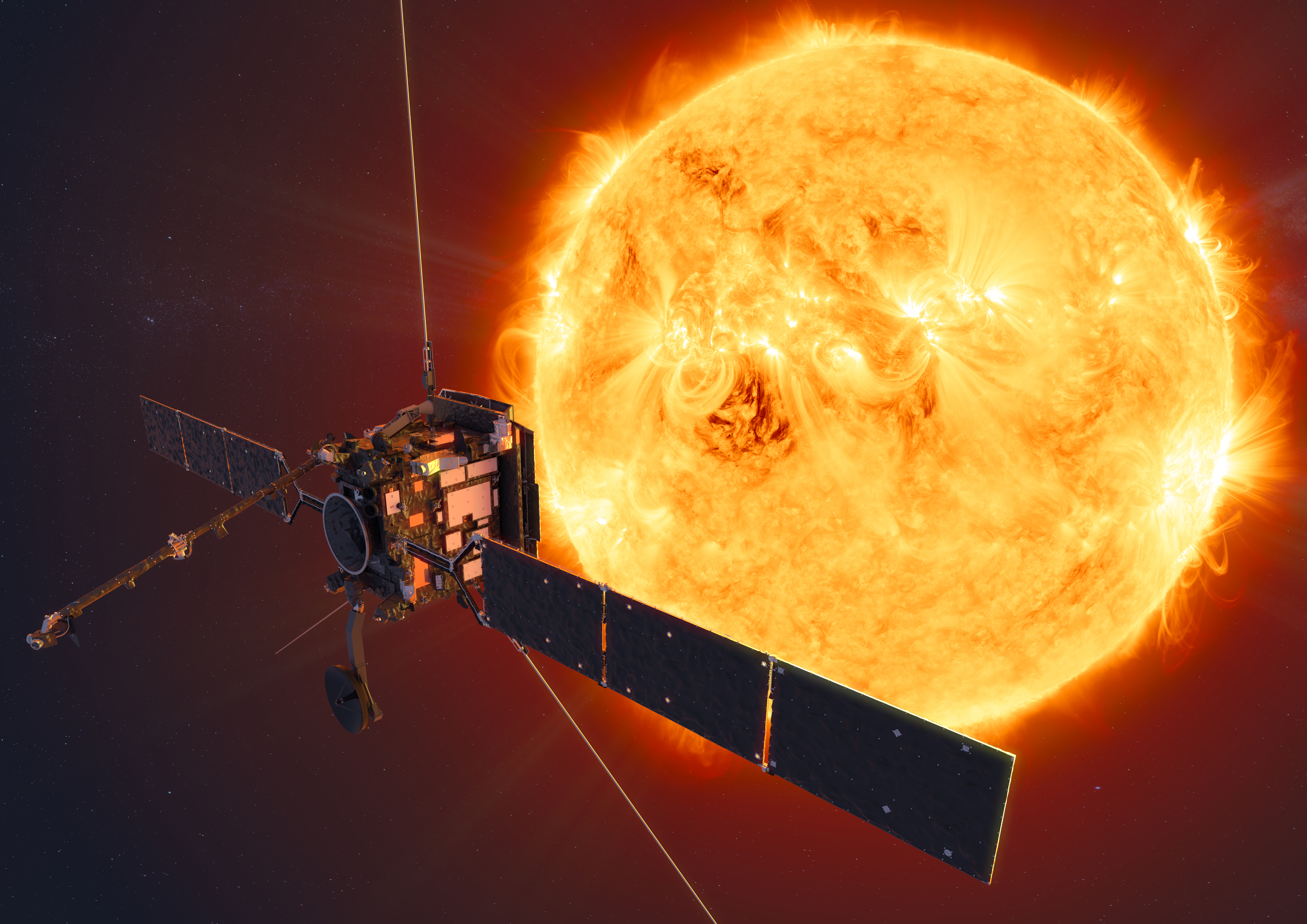Solar Orbiter - ESA Animations
Solar Orbiter is an European Space Agency (ESA) mission with strong NASA participation. Its mission is to perform unprecedented close-up observations of the Sun and from high-latitudes, providing the first images of the uncharted polar regions of the Sun, and investigating the Sun-Earth connection.

Spacecraft separation - GIF
Visualization of the separation of Solar Orbiter from the Atlas V upper stage about 53 minutes after launch.
Credit: ESA/ATG medialab
Spacecraft separation - Video
Visualization of the separation of Solar Orbiter from the Atlas V upper stage about 53 minutes after launch.
Credit: ESA/ATG medialab

Thrusters & Solar Array Deployment - GIF
Visualization showing the thrusters adjust the attitude of the spacecraft before the solar arrays are deployed. The deployment happens in two stages: the first part takes place about five minutes after separation and is spring-driven, unfolding the solar arrays to about 40% within four minutes. The second part is motorised, and will fully extend the solar arrays. This part takes about ten minutes. The solar arrays will be fully deployed by about 40 minutes after spacecraft separation. Credit: ESA/ATG medialab
Thrusters & Solar Array Deployment - Video
Visualization showing the thrusters adjust the attitude of the spacecraft before the solar arrays are deployed. The deployment happens in two stages: the first part takes place about five minutes after separation and is spring-driven, unfolding the solar arrays to about 40% within four minutes. The second part is motorised, and will fully extend the solar arrays. This part takes about ten minutes. The solar arrays will be fully deployed by about 40 minutes after spacecraft separation. Credit: ESA/ATG medialab

Boom / antenna deployments - GIF
Visualization showing the deployment of various boom/antennas. In the beginning, the first Radio and Plasma Waves (RPW) antenna is deployed. Then the boom hosting a suite of scientific instruments is deployed (MAG, RPW, and SWA to measure the magnetic and electric fields, and solar wind around the spacecraft). Subsequently, the remaining two RPW antennas are deployed. Finally, the high gain antenna dish is unfurled. In reality this sequence is spaced out over a 24 hour period. Credit: ESA/ATG medialab
Boom / antenna deployments - Video
Visualization showing the deployment of various boom/antennas. In the beginning, the first Radio and Plasma Waves (RPW) antenna is deployed. Then the boom hosting a suite of scientific instruments is deployed (MAG, RPW, and SWA to measure the magnetic and electric fields, and solar wind around the spacecraft). Subsequently, the remaining two RPW antennas are deployed. Finally, the high gain antenna dish is unfurled. In reality this sequence is spaced out over a 24 hour period. Credit: ESA/ATG medialab

Venus Flyby - GIF
Visualization of a Venus gravity flyby. Solar Orbiter will make numerous gravity assist flybys of Venus (and one of Earth) over the course of its mission to adjust its orbit, bringing it closer to the Sun and also out of the plane of the Solar System to observe the Sun from progressively higher inclinations. This will result in the spacecraft being able to take the first ever images of the Sun’s polar regions, crucial for understanding how the Sun ‘works’. Credit: ESA/ATG medialab
Venus Flyby - Video
Visualization of a Venus gravity flyby. Solar Orbiter will make numerous gravity assist flybys of Venus (and one of Earth) over the course of its mission to adjust its orbit, bringing it closer to the Sun and also out of the plane of the Solar System to observe the Sun from progressively higher inclinations. This will result in the spacecraft being able to take the first ever images of the Sun’s polar regions, crucial for understanding how the Sun ‘works’. Credit: ESA/ATG medialab

Facing the Sun Part 1 - GIF
This visualization begins by showing small sliding doors in the heatshield open to allow the internally-mounted remote-sensing instruments to observe the Sun. Special windows block out heat to protect the instruments during operations. The doors are closed when the instruments are not observing. Credit: ESA/ATG medialab
Facing the Sun Part 1 - Video
This visualization begins by showing small sliding doors in the heatshield open to allow the internally-mounted remote-sensing instruments to observe the Sun. Special windows block out heat to protect the instruments during operations. The doors are closed when the instruments are not observing. Credit: ESA/ATG medialab

Facing the Sun Part 2 - GIF
During its closest approaches of the Sun, Solar Orbiter will be travelling fast enough to study how magnetically active regions evolve for up to four weeks at a time. Credit: ESA/ATG medialab
Facing the Sun Part 2- Video
During its closest approaches of the Sun, Solar Orbiter will be travelling fast enough to study how magnetically active regions evolve for up to four weeks at a time. Credit: ESA/ATG medialab
A time-lapse of Solar Orbiter in a clean room.
Credit: ESA/ATG medialab
Visualization of the launch of Solar Orbiter on an Atlas V 411.
Credit: ESA/ATG medialab
Visualization of the Atlas V 411 fairing separation revealing Solar Orbiter attached to the rocket upper stage.
Credit: ESA/ATG medialab
Visualization of Solar Orbiter making an Earth flyby. The spacecraft will make one Earth flyby during the early stages of its mission, in November 2021. It will make numerous flybys of Venus to adjust its orbit, bringing it closer to the Sun and also out of the plane of the Solar System to observe the Sun from progressively higher inclinations. This will result in the spacecraft being able to take the first ever images of the Sun’s polar regions, crucial for understanding how the Sun ‘works’.
Credit: ESA/ATG medialab
Credits
Please give credit for this item to:
NASA's Goddard Space Flight Center
-
Producer
- Genna Duberstein (USRA)
-
Technical support
- Aaron E. Lepsch (ADNET Systems, Inc.)
-
Communications
- Emily Baldwin (EJR-Quartz for ESA)
Release date
This page was originally published on Wednesday, December 11, 2019.
This page was last updated on Wednesday, May 3, 2023 at 1:45 PM EDT.





![VideoWatch this video on the NASA Goddard YouTube channel.Music credits: “Oxide” and “Virtual Tidings” by Andrew Michael Britton [PRS], David Stephen Goldsmith [PRS]; “Progressive Practice” by Emmanuel David Lipszc [SACEM], Franck Lascombes [SACEM], Sebastien Lipszyc [SACEM]; “Political Spectrum” by Laurent Dury [SACEM} from Universal Production MusicComplete transcript available.](/vis/a010000/a013500/a013527/13537_SolarOrbiterOverview_YouTube.00725_print.jpg)